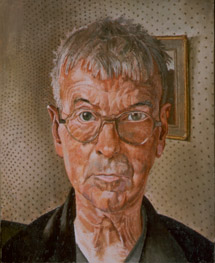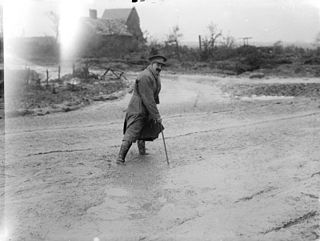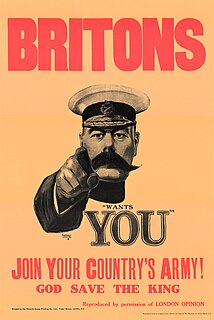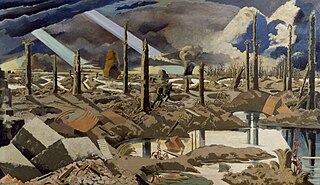Related Research Articles

Imperial War Museums (IWM) is a British national museum organisation with branches at five locations in England, three of which are in London. Founded as the Imperial War Museum in 1917, the museum was intended to record the civil and military war effort and sacrifice of Britain and its Empire during the First World War. The museum's remit has since expanded to include all conflicts in which British or Commonwealth forces have been involved since 1914. As of 2012, the museum aims "to provide for, and to encourage, the study and understanding of the history of modern war and 'wartime experience'."

Sir Stanley Spencer, CBE RA was an English painter. Shortly after leaving the Slade School of Art, Spencer became well known for his paintings depicting Biblical scenes occurring as if in Cookham, the small village beside the River Thames where he was born and spent much of his life. Spencer referred to Cookham as "a village in Heaven" and in his biblical scenes, fellow-villagers are shown as their Gospel counterparts. Spencer was skilled at organising multi-figure compositions such as in his large paintings for the Sandham Memorial Chapel and the Shipbuilding on the Clyde series, the former being a First World War memorial while the latter was a commission for the War Artists' Advisory Committee during the Second World War.

A war artist is an artist commissioned by a government or publication, or self motivated, to document their first hand experience of war in the form of an illustrative record or a depiction of how war shapes lives. War artists explore the visual and sensory dimensions of war, often absent in written histories or other accounts of warfare.

Major Sir William Newenham Montague Orpen, was an Irish artist who worked mainly in London. Orpen was a fine draughtsman and a popular, commercially successful painter of portraits for the well-to-do in Edwardian society, though many of his most striking paintings are self-portraits.

Sir Muirhead Bone was a Scottish etcher and watercolourist who became known for his depiction of industrial and architectural subjects and his work as a war artist in both the First and Second World Wars. Bone was an active member of both the British War Memorials Committee in the First World War and the War Artists' Advisory Committee in the Second World War. He promoted the work of many young artists and served as a Trustee of the Tate Gallery, the National Gallery, and the Imperial War Museum.

Anna Airy was an English oil painter, pastel artist and etcher. She was one of the first women officially commissioned as a war artist and was recognised as one of the leading women artists of her generation.
Wellington House is the more common name for Britain's War Propaganda Bureau, which operated during the First World War from Wellington House, a building on Buckingham Gate, London, which was the headquarters of the National Insurance Commission before the War. The Bureau, which operated under the supervision of the Foreign Office, was mainly directed at foreign targets, including Allied nations and neutral countries, especially the United States. The building itself has since been demolished, and its former site is now occupied by a block of flats.

Eric Henri Kennington was an English sculptor, artist and illustrator, and an official war artist in both World Wars.

The First World War, which was fought between 1914 to 1918, had an immediate impact on popular culture. In over the hundred years since the war ended, the war has resulted in many artistic and cultural works from all sides and nations that participated in the war. This included artworks, books, poems, films, television, music, and more recently, video games. Many of these pieces were created by soldiers who took part in the war.

Mary Adshead was an English painter, muralist, illustrator and designer.

Gassed is a very large oil painting completed in March 1919 by John Singer Sargent. It depicts the aftermath of a mustard gas attack during the First World War, with a line of wounded soldiers walking towards a dressing station. Sargent was commissioned by the British War Memorials Committee to document the war and visited the Western Front in July 1918 spending time with the Guards Division near Arras, and then with the American Expeditionary Forces near Ypres. The painting was finished in March 1919 and voted picture of the year by the Royal Academy of Arts in 1919. It is now held by the Imperial War Museum. It visited the US in 1999 for a series of retrospective exhibitions, and then from 2016 to 2018 for exhibitions commemorating the centenary of the First World War.
British official war artists were a select group of artists who were employed on contract, or commissioned to produce specific works during the First World War, the Second World War and select military actions in the post-war period. Official war artists have been appointed by governments for information or propaganda purposes and to record events on the battlefield; but there are many other types of war artist.
The War Artists Advisory Committee (WAAC), was a British government agency established within the Ministry of Information at the outbreak of the Second World War in 1939 and headed by Sir Kenneth Clark. Its aim was to compile a comprehensive artistic record of Britain throughout the war. This was achieved both by appointing official war artists, on full-time or temporary contracts and by acquiring artworks from other artists. When the committee was dissolved in December 1945 its collection consisted of 5,570 works of art produced by over four hundred artists. This collection was then distributed to museums and institutions in Britain and around the world, with over half of the collection, some 3,000 works, going to the Imperial War Museum.
Stephen Bone was an English painter, writer, broadcaster and noted war artist. Bone achieved early success in book illustration using woodcuts before he turned to painting and art criticism.
Walter John Bayes was an English painter and illustrator who was a founder member of both the Camden Town Group and the London Group and also a renowned art teacher and critic.
Colin Unwin Gill was an English artist who painted murals and portraits and is most notable for the work he produced as a war artist during the First World War.
The Hall of Remembrance was a series of paintings and sculptures commissioned, in 1918, by the British War Memorials Committee of the British Ministry of Information in commemoration of the dead of World War I.

The Menin Road is a large oil painting by Paul Nash completed in 1919 that depicts a First World War battlefield. Nash was commissioned by the British War Memorials Committee to paint a battlefield scene for the proposed national Hall of Remembrance. The painting is considered one of the most iconic images of the First World War and is held by the Imperial War Museum.
Dorothy Josephine Coke was an English artist notable for her work as a war artist on the British home front during the Second World War. Coke was also an art teacher and as an artist was known for her watercolours, which have a very free, open-air quality to them.
John Laviers Wheatley was a British painter, art teacher and museum director who also served as a war artist in both World War I and in World War II.
References
- ↑ Roger Tolson. "More about IWM". Art UK . Retrieved 7 October 2014.
- 1 2 3 4 Paul Gough (2010). A Terrible Beauty: British Artists in the First World War. Sansom and Company. ISBN 978-1-906593-00-1.
- 1 2 3 4 5 6 7 Merion Harries & Susie Harries (1983). The War Artists, British Official War Art of the Twentieth Century. Michael Joseph, The Imperial War Museum & the Tate Gallery. ISBN 0 7181 2314 X.
- ↑ Ulrike Smalley. "How The British Government Sponsored The Arts In The First World War". Imperial War Museums. Retrieved 5 April 2017.
- ↑ Richard Cork (1994). A Bitter Truth - Avant Garde Art and the Great War. Yale University Press & The Barbican Art Gallery.
- ↑ Catherine Speck (2014). Beyond the Battlefield, Women Artists of Two World Wars. Reaktion Books. ISBN 978 178023 374 1.